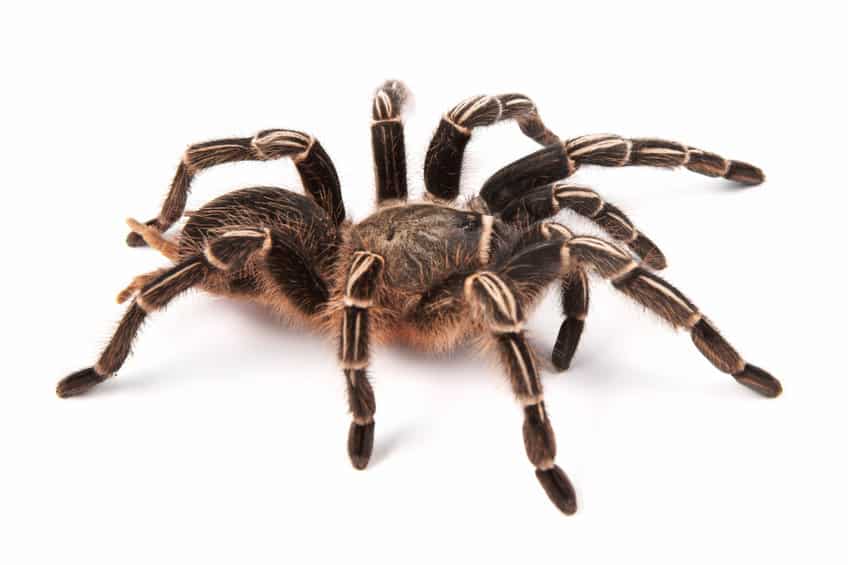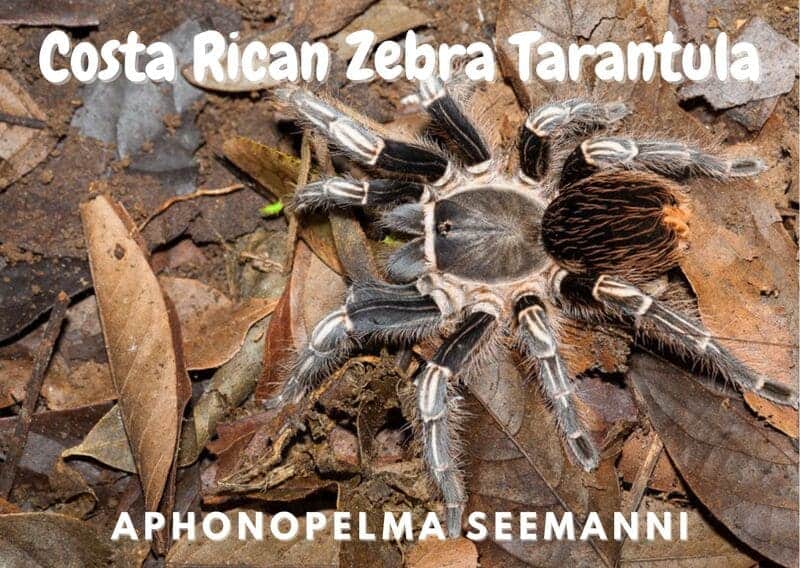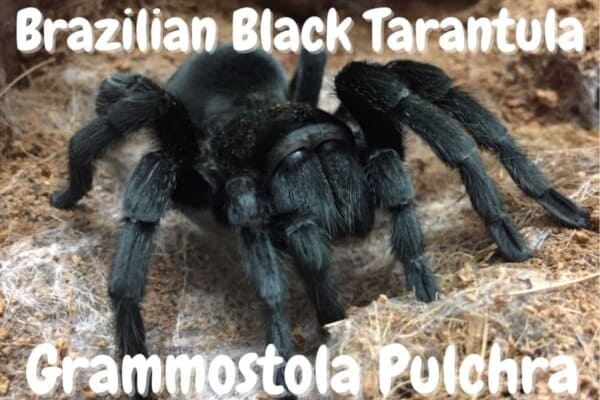The Costa Rican Zebra tarantula is no doubt a popular choice for exotic pets for its lively beauty and colorful patterns. Truly a New World spider from Costa Rica, this is a great spider for intermediate enthusiasts.
Anyone who likes their tarantulas to have personality and spirit will not be disappointed in the habits of this spider. Read further as to why the striped Zebra may be for you.
Costa Rican Zebra Tarantula Overview
| Scientific Name | Aphonopelma Seemanni |
| Dwelling | Terrestrial |
| Size | 5-6 inches |
| Lifespan | 5-10 years (male) / 20 years (female) |
| Food | cockroaches, grasshoppers, crickets, moths, pinky mice |
| Difficulty | Beginner |
Aphonopelma Seemanni (described initially by a Greek word that means ‘silent’ and ‘sole of foot’ which suits this species well)
Characteristics of the Costa Rican Zebra
This New World terrestrial is also listed as Fossorial, meaning this striped-knee tarantula likes to dig a burrow for shelter. They are native to Costa Rica and Central America including Guatemala, Honduras, and Nicaragua.
Younger spiderlings have nothing characteristic about them with a medium brown color. As they mature they begin to change in color. Mature adults can appear jet black with a blue tint or brownish colored with sandy-tipped black hair.

Leg striping often appears to have zebra-like patterns ranging from cream-colored to totally white strips. This zebra tarantula often has bluish tinting toward the front of its fangs and legs close to the carapace. Rounding their front carapace is a creamy-white brim outline. While viewing the underside the spinnerets are a pinky-peach color.
Size
As adults, the maximum length is 12-13cm (4.75-5+ inches). They have been known to reach 15cm (nearly 6 inches) in the wild. Spiderlings are typically 1/8th inch in length. They can reach 5 inches in just 4 years so they do tend to grow fast with constant feeding. When their legs reach three inches (7.62cm) they will not burrow so often. The males are generally smaller than the females by half the size.
Lifespan
The females are well equipped to live as long as 15-20 years of age. The male spiders for obvious reasons only live to perhaps 5 years if they don’t successfully mate. Experts have noted that some males can survive as long as 6- 9 years in the wild.
Difficulty of care
The Aphonopelma Seemanni Striped-knee tarantula is an intermediate-level species. Because of the recent popularity of this species, they liken this spider to Mexican red knees.
While they both share similarities, the Zebra tarantula is much more skittish and temperamental. Their nature when feeling threatened is to run rather than fight. They are not recommended for holding at all for this reason.
Housing the Costa Rican Zebra Tarantula
These spiders like to have room to stroll around in their enclosure. Ideally, you should give 4x their diagonal leg span. For an adult size, a tank enclosure a 5-gallon model designed for tarantulas is perfect. The lid needs to be firmly attached to prevent your Zebra tarantula from escaping.
It’s up to you if you buy custom models that have side openings built-in. The price will be more if you buy a glass enclosure since plastic containers are cheaper. For a spider that can live up to 20 years, you might as well invest in a glass container instead.
Cleaning
Your tarantula isn’t very messy and doesn’t need continual tank clean-up. Gradual cleaning of insect bolus is an absolute must. Especially if they happen to be small animals like lizards and pinky mice.
The spread of any kind of bacteria into your substrate is reason enough to clean your tank after any feeding. The substrate will need to change due to the humidity inside the tank. This should be changed at least once a month.
Accessories
The essential accessories you will need for this species are a reliable hygrometer, thermometer, and heating pad. The aesthetic decorations can include plastic or real plants, bark hides, and a shallow water dish. You may wish to make your enclosure even more jungle-like with decorative wall rock slabs.
Temperature and Humidity
Since your Zebra tarantula is a jungle spider, the recommended humidity needs to be 65-85%. Conditions inside the enclosure will need monitoring of the substrate if you like to mist or spray. This can raise the current humidity level quickly, so always make sure your enclosure has lid venting. When the humidity reaches 65%, a quick misting onto the substrate will return to the optimum level they enjoy.
Too little humidity can cause your striped knee to become dehydrated. Even with a water dish present it still needs that humidity level to keep from drying out. In addition to having a heating pad, it should be placed on one side of the tank (under the base of the tank) to give two zones of humidity. One side can be a cool-off zone while the other activities help to produce substrate evaporation.
Lighting
In the daytime heat of the South American jungle, it can reach 70-85F in the shade. Your Zebra tarantula will most likely retreat to their burrow to keep cool. As lighting is not a huge concern you should try to simulate the light they will encounter in the daytime. Give them at least 12 hours of incandescent lamp light and 12 hours of night conditions with no light.
Your light source should be a 40-60 watt incandescent bulb, which has the same light spectrum as the sun. Your striped knee may tend to bask in light from time to time. Color-corrected LED lights do not work well since they do not emit heat.
Substrate
The Costa Rican Zebra Tarantula will like to burrow for the first few years. After a while when it reaches full size it might not do this so often, but it does need substrate they can dig. The minimum level you should allow for this tarantula is 4-5 inches of material.
To make an adequate substrate, you will need coconut fiber, peat moss, sphagnum moss, topsoil, and vermiculite. These can be used in combination to create soil that will retain water and clump easily. The mixture is as simple as something similar to damp clay. It shouldn’t crumble either or be too wet to the touch. Of course, you will hear all kinds of recipes that are recommended, try the best mixture ratio in the next section.
Gather a mixing bucket with 25% peat moss or Sphagnum moss with 25% topsoil. Add 25% of Vermiculite with coconut fiber and add half a cup of water. Mix well and allow the contents to soak up the water. Vermiculite stores water just like topsoil does. Coconut and moss are filler. The final mixture shouldn’t be too wet or too dry. If you can form a ball in your hand that doesn’t fall apart, this is a perfect substrate.
Coconut fiber is used as a naturally antibacterial material, while peat moss also offers a preservative environment. Some owners will even add a layer of gravel on the bottom of the tank to have an extra drainage layer. Be sure to put a separating screen on top of the gravel.
Feeding Your Aphonopelma Seemanni
The types of food that the Costa Rican Zebra Tarantula will enjoy eating include cockroaches, grasshoppers, crickets, and small beetles. They will also like moths and flying insects too. On occasion, they will be eager enough to hunt little pinky mice, house geckos, and small lizards. The smaller slings will enjoy wingless fruit flies and cricket nymphs.
How often do they need feeding?
Slings need food twice a week or 4-7 days. As they molt, allow at least a day or two before feeding them. They do need their fangs and exoskeleton to harden. As long as the slings are tiny the prey needs to be an appropriate size. A good size reference is their carapace should be the size of the food offering given. Adult spiders need the same. Mature tarantulas need to be fed weekly or about every 7-10 days.
After any molt in the 2nd or third year, you need to wait for 2-3 weeks or more before their fangs and exoskeleton are tough enough. In the breeding seasons after a molt, both males and females should be fed more often.
Drink
The water dish needs to be cleaned every day. Your striped Zebra spider also needs fresh water every day. They can become dehydrated if the water is not provided in the heat and humidity of the tank enclosure.
Find a spot where you can take a Snapple cap or shallow milk bottle lid. Bury it just at the surface level of the substrate. These spiders will drink often, so make sure they have plenty of it.
Handling the Costa Rican Zebra Tarantula
This species is known for being docile enough however the online popularity has given the alarm to pet shops not being properly informed about their temper-sensitive nature. These are skittish spiders that will feel threatened by sound, voice tone, and sudden movements. They are also fast-moving in bursts and will run to escape a threat.
It’s common to see these tarantulas flicking urticating hairs from their abdomen that are itchy and rash-like to your skin. Also, they will raise two front arms in defense when threatened. While this is sometimes a bluff, don’t push it further. They are not biters but their bite will not be dangerous to humans. It will have the same toxicity as a bee sting. Those who are allergic to this kind of venom will be more at risk.
Costa Rican Zebra Tarantula – Common health problems
Many new owners of the Aphonopelma Seemanni are not well informed about the temperature and humidity needs. They can suffer ill effects if their climate needs are not met properly. As long as you keep these levels constant they will not be sick.
At times before any molting period, they will stop feeding. This is so they will be thin enough to escape from their exoskeleton. Around this time you will see them being pretty lazy or less active than usual. If you keep a log of molting times they have gone through, you can time it to an annual molt after the first year.
If you have never owned a striped knee it will be shocking to see them in their tank upside down. Their legs will be outward as if they died. Do not disturb them at this time. Give the tank a generous spray to increase the humidity.
Leave them alone and they will exit their exoskeleton in time. After molting they will retreat to their burrow to harden up.
The only other health concern can come from mites that do not present a huge problem for your spider. Mite and parasite infestations are tragic and can lead to the death of your spider. This is why the monthly cleaning of the substrate will keep this from happening.
Breeding tips for the Costa Rican Zebra
Females reach maturity after 5-6 years. If you want to breed them you need to know how old they are when you purchase them. Males can peak at 2 to 3 years which is almost always how long they end up living if they do breed. The breeding time will depend on their most recent molt. They need up to 4-6 weeks or more after the molt to show signs they are ready to mate.
The male will begin to make a web that he then rubs his body onto to collect the sperm. This web is then transferred to his front legs which act as sperm sacks. If you introduce a male into the female’s enclosure, be careful to remove the male after he has finished. The female (if not fed enough) will try to eat the male as part of the mating ritual. Many male spiders aren’t so lucky at this time and can be bitten and die.
How many eggs at a time?
The female will begin the process of hatching anywhere from 50-2000 eggs. They are certainly one of the easier tarantulas to breed with. It takes 6-8 weeks for the eggs to mature and hatch. It the silk cocoon is not removed before that time spiderlings that first hatch will start to eat the remaining eggs.
What to do with the spiderlings
Spiderling tends to remain in their mother’s burrow for some time before leaving. This can be because their food source is inside the burrow and unhatched eggs will be their primary food stable. It can be a shock to see several hundred spiderlings inside your tank too. This is why most breeders will remove them to deposit each egg into a small plastic dipping sauce container with a lid.
You may decide to bring them to an authorized spider collector or exotic pet retail store to sell them. These spiderlings can fetch decent prices online so most breeders will make the most of their stock and trade. It might be worth selling them off in batches or individually.
Availability of the Costa Rican Zebra Tarantula
As popular as this Zebra striped knee can be, they are not very expensive. Slings can cost on average around $30 while juvenile males can be $75, and juvenile females $100 plus.
Prices can rise and fall depending on where you live, and the internet is full of online sales too. This species is not uncommon but has become exceptionally popular in recent years.
Contents
- Costa Rican Zebra Tarantula Overview
- Characteristics of the Costa Rican Zebra
- Housing the Costa Rican Zebra Tarantula
- Feeding Your Aphonopelma Seemanni
- Handling the Costa Rican Zebra Tarantula
- Costa Rican Zebra Tarantula – Common health problems
- Breeding tips for the Costa Rican Zebra
- Availability of the Costa Rican Zebra Tarantula













